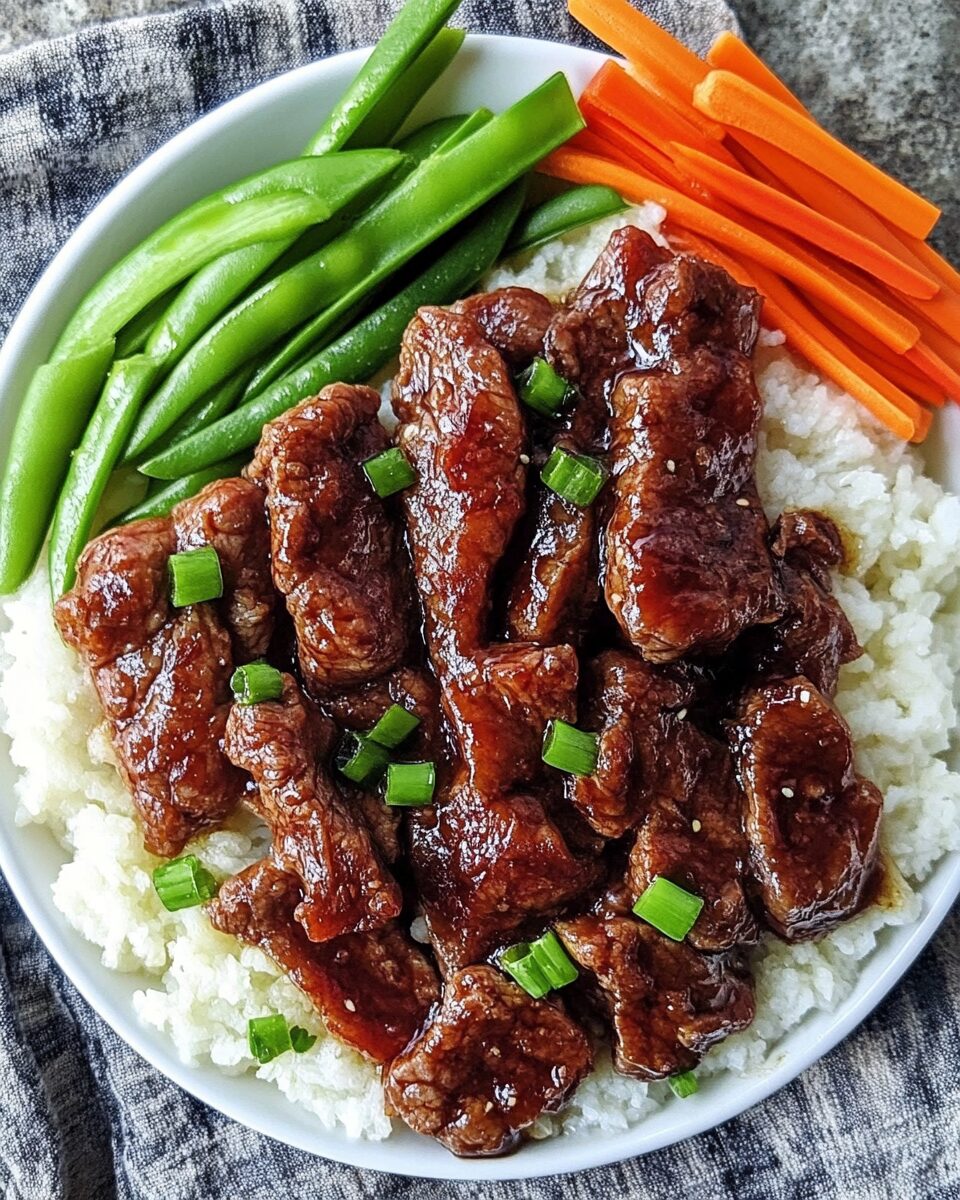The perfect balance of sweet and savory, this Mongolian Beef recipe brings restaurant-quality flavor right to your kitchen. Thin slices of sirloin are flash-seared for that caramelized outer crust, then tossed in a garlicky soy-brown sugar glaze with just a touch of heat. It’s rich, bold, and irresistible.
Whether served over fluffy jasmine rice or tucked into lettuce wraps, this dish is quick to make but packs major flavor. The green onions give it a fresh bite and the chili oil adds a gentle spice that takes the flavor to the next level. It’s a fast and fulfilling dinner idea for busy nights when you want something special without the fuss
Full recipe:
Ingredients:
-
1½ pounds sirloin steak, 1-inch thick
-
⅓ cup cornstarch
-
¼ cup canola oil
-
¼ teaspoon salt
-
1 tablespoon fresh grated ginger
-
4 tablespoons garlic, minced
-
Red pepper flakes or chili oil, to taste
-
⅓ cup reduced sodium tamari (or soy sauce)
-
½ cup water
-
⅓ cup brown sugar
-
8 scallions (green parts only), cut into 2-inch pieces
Directions:
-
Slice steak into ¼-inch slices. Lay them flat, cover with plastic wrap, and gently pound to tenderize.
-
Place steak into a zip-top bag, add cornstarch, and massage until fully coated. Let rest for 15 minutes.
-
Heat canola oil in a large skillet over medium-high heat.
-
Add steak slices in a single layer, searing for 30 seconds per side. Do this in batches to avoid overcrowding. Set aside.
-
Add ginger, garlic, and chili oil or red pepper flakes to the skillet. Sauté for 10–15 seconds.
-
Stir in tamari (or soy sauce), water, and brown sugar. Bring to a boil.
-
Return steak to the pan and let the sauce thicken for 20–30 seconds.
-
Turn off heat, add scallions, and stir to combine.
-
Serve over jasmine rice, rice noodles, or in lettuce wraps.
Prep Time: 15 minutes | Cooking Time: 15 minutes | Total Time: 30 minutes
Kcal: 478 kcal | Servings: 6 servings
The Origins and History of Mongolian Beef
While the name “Mongolian Beef” might lead you to believe that the dish originates from Mongolia, its roots are actually in Chinese-American cuisine. The dish is inspired by the flavors of Chinese stir-fries, with its distinctively sweet and savory sauce. It became popular in the United States in the 20th century, particularly in restaurants that served Chinese-inspired food to American tastes. The recipe, as we know it today, was most likely popularized by chain restaurants like P.F. Chang’s, which helped introduce this dish to a wider audience.
Mongolian Beef is not a dish that can be found in traditional Mongolian cooking, and it’s actually a fusion dish that highlights the creative ways that Chinese culinary traditions have evolved when adapting to different cultures. It’s one of those dishes that captures the essence of what many people love about Chinese-American food: the balance of salty, sweet, and spicy, combined with tender beef and aromatic vegetables.
What Makes Mongolian Beef Special?
The charm of Mongolian Beef lies in its simplicity and the perfect balance of its flavors. At its core, the dish is made with thinly sliced beef that’s been seared in a hot pan to develop a nice caramelized crust. The sauce, a key element, is a mix of soy sauce, brown sugar, garlic, ginger, and often a bit of chili oil or red pepper flakes, which adds depth and warmth to the dish. The sauce has a sweet, savory profile that coats the beef, making it tender and flavorful.
What makes Mongolian Beef unique is the combination of ingredients that create a multi-layered flavor experience. The soy sauce offers saltiness and umami, the brown sugar provides sweetness, while the garlic and ginger lend aromatic heat and depth. A dash of chili oil or red pepper flakes introduces a gentle kick that makes each bite more exciting. The beef used in this recipe is typically sirloin or flank steak, which are both flavorful and become tender quickly when cooked properly, making them ideal for stir-frying.
Tips for Making the Perfect Mongolian Beef
When preparing Mongolian Beef, there are a few key tips that can elevate your dish to the next level. First and foremost, using the right cut of beef is essential. While flank steak is commonly used, sirloin steak is also a great option because it has a good balance of tenderness and flavor. Thinly slice the meat across the grain, which helps ensure it remains tender when cooked.
Next, it’s crucial to use cornstarch to coat the beef. This step is often overlooked, but it’s the secret to achieving that crispy exterior while keeping the interior tender. After coating the beef with cornstarch, allow it to sit for a few minutes to let the coating set. This will help the beef achieve a nice sear when cooked.
Cooking the beef in batches rather than overcrowding the pan is another important step. If you overcrowd the pan, the beef will steam rather than sear, which can result in a soggy texture. The goal is to get a crispy crust on the beef, and this requires the beef to be cooked in a single layer with plenty of space in the pan.
For the sauce, it’s important to bring it to a boil after adding the soy sauce, water, and brown sugar, and then let it simmer for a few moments to thicken. This allows the flavors to meld together and the sauce to reduce slightly, creating a perfect glaze that will coat the beef.
Creative Serving Suggestions for Mongolian Beef
Mongolian Beef can be served in many different ways, depending on your preference and dietary needs. Traditionally, it is served over steamed white rice, which helps balance the richness of the beef and sauce. The rice acts as a neutral base that soaks up the savory sauce, making it the perfect complement to the dish. For a healthier twist, you can substitute the white rice with brown rice, which adds a nuttier flavor and extra fiber.
Another popular option is to serve Mongolian Beef in lettuce wraps. This makes for a light and refreshing alternative to rice. Simply spoon the beef mixture into large, crisp lettuce leaves and enjoy. This method is great for those following low-carb or gluten-free diets, as it eliminates the need for rice or noodles.
For a more luxurious take on the dish, you can serve Mongolian Beef with rice noodles. The noodles provide a satisfying texture that pairs well with the tender beef and the flavorful sauce. You can also add a handful of sautéed vegetables, such as bell peppers, carrots, or snap peas, to the dish for added color and crunch.
If you want to make this dish even more filling, you can also pair it with a side of steamed vegetables or a simple Asian-inspired slaw. The combination of textures – tender beef, crisp vegetables, and soft rice or noodles – creates a satisfying and well-rounded meal.
Why You Should Try Mongolian Beef
Mongolian Beef is an easy-to-make, flavorful dish that’s perfect for busy weeknights or when you’re craving a comforting meal. It’s quick to prepare, requiring only about 30 minutes from start to finish, and it’s packed with bold, satisfying flavors. The combination of sweet, savory, and spicy elements makes it a dish that’s universally loved and can be adjusted to suit any taste or dietary need.
Furthermore, this dish offers the versatility to be served in a variety of ways, whether over rice, noodles, or lettuce wraps. It’s also a great choice for meal prepping, as it can be stored in the fridge and reheated easily without losing its flavor or texture.
Conclusion: Why Mongolian Beef is a Must-Try Recipe
In conclusion, Mongolian Beef is a flavorful, satisfying dish that offers a wonderful balance of tastes and textures. Whether you’re making it for a casual dinner or serving it at a dinner party, this dish is sure to be a hit with your guests or family. With its simple ingredients, quick cooking time, and endless customization options, Mongolian Beef is a must-try recipe that’s both delicious and versatile.
By following a few key cooking tips, you can ensure that your Mongolian Beef turns out perfectly every time. And with the ability to customize the dish to suit different diets or preferences, this recipe is one that you’ll want to add to your regular rotation. So, the next time you’re craving something sweet, savory, and just a little bit spicy, look no further than Mongolian Beef.






